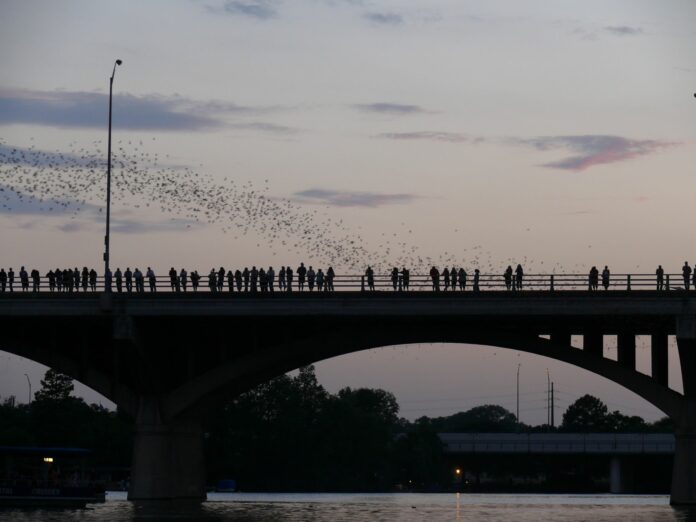
BY HARRY WEEKES
Imagine this: You are a biology nerd and over the course of your 53 laps around the sun you have rubbed shoulders (and, occasionally, hands and heads) with our friends, the chiroptera—the bats. On one hand, the reason is simple—bats make up almost 20% of all mammals, which means that as the second most speciose group of fur-covered fuzzballs outside of the rodents, it is hard not to hear about and otherwise come in contact with them. This brings us to the other hand, which highlights bats because of the way they have flitted, dodged and dipped their way into our culture, from their malevolent association with vampires to their benevolent association with crimefighter Bruce Wayne.
So, when someone asks, “Are you up for going to Austin, Texas, to see Willie Nelson?” the thoughts that dart across your mind have less to do with Country-Western crooning than with something about a bridge and a whole lot of bats. The answer, of course, is “Yes.”
And so it was that I found myself standing on the Congress Avenue Bridge in Austin, Texas, about 30 minutes before sunset, right smack in the dab of “the season,” with a growing throng of folks getting ready to be wowed by bats. Several hundred thousand bats. Several hundred thousand Mexican free-tailed bats that find the undersides of the bridge the perfect place to roost and have their babies.
Nightly, there’s a one- to two-hour window when the show happens, when great columns of bats shoot out into the darkening skies to eat something like 30,000 pounds of insects. This major ecosystem service bats provide, and the spectacle of miles of bats streaming into Texas sunset skies, turned a perceived nuisance and public hazard into a welcome and celebrated showcase, now embraced and promoted.
On our way across the bridge, a film crew was interviewing a kindred spirit—an older man in what can only be called a “biology outfit,” complete with notebook in his pocket and camera around his neck. While I stood off to the side with Georgia (we’re the shy biological types), my wife and Georgia’s boyfriend Connor (the not-shy biological types) got closer, then demanded we come over to meet none other than Dr. Merlin Tuttle, quite literally the Batman of biology nerds. And so it was that I stood shoulder to shoulder with Dr. Tuttle and a Bolivian film crew and watched… the sun set, and darkness fall, and no bats emerge.
Dr. Tuttle’s reasoning for one of the “worst nights he’s seen”—simple, it had been wet, there were lots of bugs, and the bats weren’t hungry enough to come out before it was totally dark, when they could emerge more safely (they are preyed upon by raptors). And maybe, Dr. Tuttle added, as necessary micro-meteorologists, the bats somehow knew that the weather fronts that push the insects they eat into the air were not going to be best until later, so they just waited. Hmmmm. Think about that knowledge.
There were some apologies to me as we shuffled off the bridge, mostly because it felt like the viewing was a bust. In terms of bats seen, that was certainly the case. But there is something important in appreciating what we didn’t see, something that cuts across all of my usual observations: the power of mystery, how not being able to predict things is an important lesson in everything from productive wonder to humility, that despite so much of our desire to the contrary, Nature, the big ‘N,’ actually works on her own rhythms, not ours. Sometimes, many times, you go out filled with expectation and hope, and you hit pause.
They tell me there are Mexican free-tailed bats in Austin. Of the million or so clinging to the concrete within twenty feet of my shoes, I did not see a single one. And it was awesome.
Harry Weekes is the founder and head of school at The Sage School in Hailey. This is his 50th year in the Wood River Valley, where he lives with Hilary and one of their three baby adults—Simon. The other members of the flock, Georgia and Penelope, are currently fledging at Davidson College in North Carolina and Middlebury College in Vermont, respectively.
